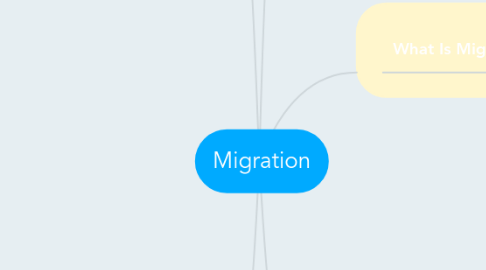
1. Where Do People Migrate?
1.1. -Global migration flows
1.1.1. -Pre-1500
1.1.1.1. -Happened haphazardly
1.1.1.2. -Due to exploration, pursuit of goods or fame, and colonization
1.1.2. -Post-1500
1.1.2.1. -Huge amount of migration
1.1.2.2. -Large amounts of people migrating to the Americas
1.1.2.3. -As places were discovered, humans began spatially distributing themselves and colonizing across the globe
1.2. -Regional migration flows
1.2.1. -Economic Opportunities
1.2.1.1. -Main basis of regional migration
1.2.1.1.1. -def. coastal cities established based on access to trade
1.2.2. -Reconnection of Cultural Groups For example, reuniting jews in 1948
1.2.3. -Conflict and war For example, after WWII many Germans fled their home voluntarily or forced.
1.3. -National migration flows
1.3.1. -Internal migration flows For example, the westward expansion and post-Civil War African-American movement
1.4. -Guest workers
1.4.1. -Migrate to work in other countries and return home Remittances
1.4.2. -Money sent by guest workers back to home countries
1.5. -Refugees
1.5.1. -Characteristics of refugees
1.5.1.1. -Most refugees move without any more tangible property than they can carry or transport with them
1.5.1.2. -Most refugees make their first "step" on foot, by bicycle, wagon, or open boat
1.5.1.3. -Refugees move without official documents that accompany channeled migration
1.5.2. -Regions of dislocation
1.5.2.1. -Subsaharan Africa
1.5.2.2. -North Africa and Southwest Asia
1.5.2.3. -South Asia
1.5.2.4. -Southeast Asia
1.5.2.5. -Europe
2. How Do Governments Affect Migration?
2.1. -Legal Restrictions
2.1.1. -The restrictions to immigrate are usually legal, not physical.
2.1.2. -Immigration laws are laws preventing immigrants to enter the country.
2.2. -Post 9/11
2.2.1. -After Sept. 11 U.S. borders became more strict and harder to cross.
2.2.2. -New policies were also introduced which made it much harder to become a citizen.
2.3. -Waves of Immigration in the United States
2.3.1. -When the U.S. allowed immigration they received many migrants from Europe.
2.3.2. -In 1921 congress created a quota whereby each year the U.S. only permitted 3% of Europeans coming to the U.S., this was lowered to 2% in 1924 then to 150,000 immigrants.
2.3.3. -In 1940 they gave the equal laws to immigrants from China.
2.3.4. -The U.S experienced 2 major waves of migration before 1930 and is currently experiencing one.
3. Field Note
3.1. Boat People
3.1.1. -Across the world hundreds of thousand of people flee their homelands on boats seeking better opportunities. Example of boat people Haitians.
3.2. Remittances
3.2.1. -Economies of poorer countries in the Caribbean, Africa, Central and Southern America depend on remittance sent to their citizens.
3.2.2. -Each year Haitians in the U.S. send home $350 million dollars.
3.3. Legality & Opportunities
3.3.1. -Not all immigrants are illegal, about 24 million out of the 34 million immigrants in the U.S. are legal.
3.3.2. -Immigrants are willing to risk their lives to find better living conditions and opportunities than their previous home.
4. What Is Migration?
4.1. -Cyclic Movement
4.1.1. -Shorter periods away from home, always going back to home.
4.1.1.1. -Commuting to work or school.
4.1.1.2. -Seasonal movement, many people in the autumn move south to warmer climate.
4.1.1.3. -Nomadism is movement with things necessary to survival such as following animals on regular trials.
4.1.2. -Movement creates activity spaces.
4.2. -Periodic Movement
4.2.1. -Longer periods from home but still returning home.
4.2.1.1. -Migrant labor, people move to work on large fields.
4.2.1.2. -Transhumance, the movement of livestock in accordance to the climate in which people follow for the season.
4.2.1.3. -Attending college, you spend a great amount of time there yet still have a home address.
4.2.1.4. -Military service, millions of people are moved to new locations on tours of duty.
4.3. -Migration
4.3.1. -Human movement has sped up due to increased mobility over time.
4.3.2. -Human movement speeds diffusion of ideas and innovations.
5. Why Do People Migrate?
5.1. -Forced Migration
5.1.1. -Nazi Germany forced Jews to migrate to concentration camps.
5.1.2. -Most known forced migration is the Atlantic slave trade.
5.1.2.1. -Distributed slaves across North and South America and had a significant effect on population
5.1.2.2. -Have been and are still more forced migrations, but not nearly as large
5.1.3. -Britain shipped over 10,000 convicts to Australia.
5.2. -Push & Pull Factors in Voluntary Migration
5.2.1. -Ernst Ravenstein's Laws of Migration
5.2.1.1. -1.Every migration flow generates a return or counter-migration
5.2.1.2. -2.The majority of migrants move a short distance
5.2.1.3. -3.Migrants who move longer distances tend to choose big-city destinations
5.2.1.4. -4.Urban residents are less migratory than inhabitants of rural areas
5.2.1.5. -5.Families are less likely to make international moves than young adults
5.2.2. -Gravity Model
5.2.3. -Step Migration
5.2.4. -Intervening Opportunity
